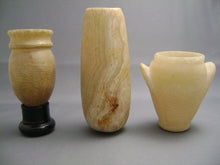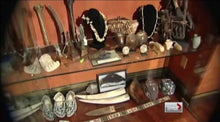Ancient Egyptian Alabaster Vessels – Ex. Gustave Jequier (1868-1946)
Regular price
$8,995.00
Sale
New Kingdom to Late Period, 1550-343 B.C.
Including a New Kingdom jar, ovoid in form with a pointed base and a collar at the mouth; a Late Period alabastron, of tapering cylindrical form, on a flat base, the now-missing neck made separately; and a New Kingdom jar, ovoid in form, on a pad base, with slightly flaring rim and twin inverted U-shaped handles Tallest: 4 ¼ inches (10.7 cm) high.
Picture attached of items when it was part of the Bill Jamieson collection.
Provenance: Collected by Gustave Jéquier (1868-1946)
Ex. William Jamieson (1954-2011)
Authentication: Gayle Gibson, Royal Ontarion Museum Toronto and Christie's.
Galleria Delvecchio .… “is pleased to present a collection of Egyptian antiquities assembled by the celebrated Swiss Egyptologist Gustave Jéquier. Jéquier was born in 1868 in Neuchatel. He first studied in Paris under Gaston Maspero (1846-1916) and later went to Berlin before joining the de Morgan expedition to Persia, during which time he contributed to the discovery and decipherment of the code of Hammurabi. Gustave Jéquier was a giant in the field of Egyptology whose contributions are far too numerous to list here. He is best know for his association with the French Institute in Cairo which enabled him to engage in seminal research at the pyramid site of the Old Kingdom. He also completed the work begun at Abydos by his Swiss compatriot, [Henri] Eduard Naville (1844-1926). The two are considered to be Switzerland’s most preeminent Egyptologists. One of Jéquier’s most important discoveries was the 13th Dynasty pyramid of Khendjer. He wrote extensively on his history of Egyptian architecture, and published on philology and religion as well. Gustave Jéquier died in 1946 in the city in which he was born, and most of his collection was acquired by the University of Basel. The works of art presented here were given to a sibling who emigrated to the US in the late 1940’s; the collection later passed to their daughter, Jéquier’s niece.”




